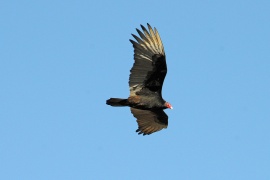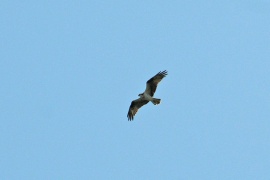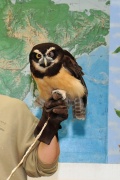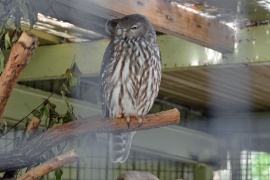1
The word Raptor comes from the Latin word rapere, meaning to seize, or snatch away. The term is used in reference with the way many raptors kill their prey with their feet.
Raptors include hawks, eagles, kites, vultures, condors, harriers, kestrels, falcons, owls and the secretarybird. Raptors are often referred to as birds of prey, as they are frequently active hunters (aside from the vultures and condors, which are primarily carrion eaters). A common characteristic among raptors are their sharp, curved talons for catching and holding prey, their curved upper bill for tearing flesh, and often their keen eyesight, hearing and/or sense of smell, used for finding their food.
2
2a
Raptors are divided into two broad groups, the diurnal raptors (those active in the day), such as hawks, eagles, kites, falcons and osprey, and the nocturnal raptors (those active at night), which comprise the typical owls and the barn owls.
2b
Raptors are currently divided into three Orders under the Class Aves:
Order Accipitriformes (accipiter, from the Latin word meaning hawk)
- Family Accipitridae: including the hawks, eagles, and kites, some 217 species worldwide
- Family Cathartidae (cathartes, from the Greek word meaning purifier): the seven species of vultures and condors
- Family Pandionidae (Pandion, from the Greek legend, the father of Procne, changed into a swallow): the two species of Osprey
- Family Sagittariidae (Sagittarius, Latin for archer): One species of Secretarybird
Order Falconiformes (likely from falx, from the Latin meaning sickle, referring to the curved beak)
- Family Falconidae: Some 60 species of falcons and their allies, including the Caracaras
Order Strigiformes (strix, from the Greek meaning to screech)
- Family Strigidae: Some 124 species of owls worldwide
- Family Tytonidae (Tyto, from the Greek for owl): The ten species of Barn Owls
2c
Raptors are generally characterized by their sharp, curved talons, their sharp, powerful curved beaks, and their keen eyesight. The vultures (Cathartidae) do not have powerful talons, as they do not hunt live prey. The Turkey Vultures and the Yellow Headed Vultures have a very strong sense of smell, something that isn't shared by the Black Vulture, which finds its prey by sight - or by following the Turkey Vulture.
Eyes: Raptor eyes are very large for their head, and more forward pointing to allow binocular vision, which is important for determining distance to prey. Like many other birds, raptors are also able to see in the ultraviolet light spectrum, which may reveal the trails of potential rodent prey. Their overall vision is considered some eight times as powerful as a human, which is important as they fly far overhead, seeking small rodents and other prey. Diurnal raptors have good color vision, but nocturnal raptor eyes are instead designed to pick up every scrap of light, given their nighttime hunting habits.
Protecting the eye is a bony ring, called the sclerotic ring, but while this helps keep the eye safe from injury, it also limits the raptor’s ability to turn its eyes, thus they turn their head to adjust where they are looking and ascertain distance to prey. To facilitate this manner of looking around, raptors have the ability to rotate their heads quite a bit, with some owls able to turn their heads more than 180 degrees around, looking completely backwards and then some.
Another way raptors protect their eyes is with three eyelids, two outer ones that close up-and-down, and an inner translucent eyelid, called a nictating membrane, which opens and closes fore-and-aft. The nictating membrane may be closed while a raptor is digging its beak into its prey, to avoid getting things in its eyes, and the osprey is known to close the membrane before diving into water.
Talons/Feet: With the exception of the vultures (Cathartidae), most raptors capture their live prey with their feet/talons. The feet are strong, and in diurnal raptors the lower legs are often bare (whereas many owls may have feathers even on their feet). The claws may be long and strongly curved, as in Osprey or falcons that catch fish or birds on the wing, or shorter for raptors hunting much larger prey. Most raptors have three toes facing forward and a fourth facing backwards, but owls and osprey can turn their small tow backwards, to have a two two configuration, for better balance or grip.
Beaks: The common raptor beak shape is a sharp hook, designed to tear flesh, pull off feather and fur, and pierce flesh. Raptors do not chew their food, so they need to either swallow it whole, or tear it into bite sized pieces. Vultures, which eat carrion, may have slightly longer and straighter beaks, able to stick deeper into a carcass. Vultures also may have few or no feathers on their head, to avoid getting food in their feathers.
Many falcons, and some hawks and other accipiters, have a special extra projection on the outside edge of the upper mandible (beak) just behind the sharp curved tip. This is called the Tomial Tooth, and may be matched by a notch in the lower bill called the Tomial Notch. The falcons use this to quickly sever the spinal column of their small prey, quickly killing it.
2d
Use this to find how many of each family are in your area, and then see of you can find them. Some examples include:
- Accipitridae: The largest and most diverse family of raptors. Includes the Bald Eagle, Red-Tailed Hawk, and Mississippi Kite, among others. Below are a small selection of raptors found in the Family Accipitridae.
- Cathartidae: There are seven recognized species in the Family Cathartidae: Turkey Vulture (Cathartes aura), Lesser Yellow-Headed Vulture (Cathartes burrovianus), Greater Yellow-Headed Vulture (Cathartes melambrotus), Black Vulture (Corygyps atratus), California Condor (Gymnogyps californianus), King Vulture (Sarcoramphus papa) and the massive Andean Condor (Vultur gryphus)
- Pandionidae: There are now two recognized species of Osprey (formerly there was only one recognized species): the more common Western Osprey (Pandion halietus), and the Eastern Osprey (Pandion cristatus), which occurs between Sulawesi, Australia and New Caledonia.
- Sagittariidae: There is only one species in this family, the Secretarybird (Sagittarius serpentarius), found in Africa.
- Falconidae: Falconidae are divided into two sub-families, Falconinae and Polyborinae. The former has four genera, and includes the ubiquitous Peregrine Falcon (Falco peregrinus), the Merlin (Falco columbarius) and the American Kestrel (Falco sparvarius), as well as the tiny Black-Thighed Falconet (Microhierax fringillarius). The Polyborinae comprises seven genera, and includes the Crested Caracara (Caracara cheriway) and the Barred Forest Falcon (Micrastur ruficollis).
- Strigidae comprises some 27 genera of “typical” owls in three sub-families, and includes the massive Eurasian Eagle-Owl (Bubo bubo), the Great Grey Owl (Strix nebulosa), the tiny Northern Pygmy Owl (Glaucidium gnoma) and the equally diminutive Elf Owl (Micrathene whitneyi), and the Great Horned Owl (Bubo virginianus).
- Tytonidae is divided into two sub-families, each with just a single genus. Among the Tytonidae are the Oriental Bay Owl (Phodilus badius), the Common Barn Owl (Tyto alba), and the Australian Masked Owl (Tyto novaehollandiae).
3
- a. Eyes
- b. Feet & Talons
- c. Chest
- d. Body
- e. Beak
- f. Ears
- g. Wings
- h. Feathers
The flight feathers in raptors are called Retrices on the tail, Remiges on the wings. The main feathers responsible for flight on the wings are divided into the Primary feathers (Primaries), the Secondary feathers (Secondaries), and at times Tertiary feathers.
The ears are usually hidden behind the feathers, and occur a little below and behind the eye. "Eared" owls, those with tufts sticking up on either side of the head, also have their ear in the normal place - the raised tufts are not related to the ear location.
The third picture above is a close up shot of owl talons. Note the sharp, curved claws, used for grasping prey.
4
4a
The smallest diurnal raptors are the Black-Thighed Falconet and the White-Fronted Falconet, the former, found on peninsular Malaysia and southern Thailand, Borneo, Sumatra and Java, measures 14-17 centimeters (5.5-6.7 inches) and weighs 28-55 grams (0.06-0.12 pounds). The latter is found in northern Borneo, also measuring 14-17 centimeters (5.5-6.7 inches), weighing 35-65 grams (0.08-0.14 pounds).
The smallest diurnal raptor in the United States is the American Kestrel, which by comparison is a massive 22-31 centimeters (8.7-12.2 inches) long, and 80-165 grams (0.18-0.36 pounds).
The smallest nocturnal raptor is a toss-up (depending upon the individual specimen) between the Northern Pygmy Owl (at 16-18 centimeters/6.3-7.1 inches long), found through Central America, Mexico, the western United States to Canada, and the Elf Owl, living in the American southwest and south central states and Mexico, at 13-30 centimeters (5.1-11.8 inches) long, and weighing around 40 grams (0.09 pounds).
The Pygmy Parrots of New Guinea are the smallest parrots, measuring just 3.5-4 inches in length. The African Pygmy Goose, weighing in at just around six-tenths of a pound and measuring 12 inches in length, is the smallest of the waterfowl.
4b
The largest diurnal raptor by wingspan is the Andean Condor (image below), measuring in at 10 feet or more across. By weight, it is the California Condor, at 31 pounds.
The largest nocturnal raptor by weight is either the Eurasian Eagle-Owl, measuring 2-2.5 feet with a wingspan of 5-6 feet (weighing 3-9 pounds), or the endangered Blakiston’s Fish Owl, measuring 2-2.3 feet and weighing 6.5-10 pounds. By size (but not weight), the Great Grey Owl tops both, measuring 2-2.75 feet with a wingspan of up to five feet, but weighing in at only 1.3 to slightly over 4 pounds.
By comparison, the largest parrots, the Hyacinth Macaw, can reach a length of some 3.3 feet, and the flightless Kakapo can weigh up to 4.5 pounds, and the largest waterfowl are the Trumpeter Swan, with a 10 foot wingspan and weighing in at some 38 pounds.
4c
As would be expected from such a diverse group, raptors build many different types of nests.
Some build large stick nests, among them the Bald Eagles, Osprey, Secretarybird, Crested Caracara, and Red-Shouldered Hawk. Osprey nests are usually atop a solitary pole, Caracara may place their nests atop a small tree or palm.
Others scrape out nesting sites on cliffs, such as the Peregrine Falcon, or the Merlin (which may also use old nests of other raptors).
Several types of owls nest in natural cavities in trees, including the Screech Owl, while the Elf Owl prefers to nest in old woodpecker holes in Cacti. The Common Kestrel is another cavity nester.
Most vultures do not bother building nests at all, laying their eggs in tall grasses, natural hollows in rocks or on cliffs, or in fallen hollow logs.
The Burrowing Owl, as its name suggests, prefers to nest in ground burrows, usually ones abandoned by mammals.
4d
Among the raptors, a general rule is that the smaller the species, the shorter the lifespan. Small raptors live 3-15 years, though for nearly all raptors, the first 1-3 years are the most dangerous, and the time they are most likely to be killed prematurely. Larger raptors live 20-40 years, and perhaps even longer in captivity for some species.
Like the raptors, smaller parrots have shorter lifespans, perhaps some 15-20 years, while the larger species may live 80 or more years. For waterfowl, some geese may live well over 20 years, while other ducks may have shorter average lifespans, in the 8-20 year range.
4e
With the exception of the vultures (Cathartidae) which are carrion-eating scavengers, most raptors are active hunters, using their keen eyesight (watch them flying, and you will often see their head cocked to one side looking down) to find prey, and their sharp talons to capture the prey. Most falcons (Falconidae), as well as some Kites and other Accipiters, have a well developed extra "bump" on the outer edge of their upper mandible (beak) just behind the curved tip. This is referred to as the Tomial "tooth," and is thought to assist the falcons in quickly killing their captured prey by severing the spinal column.
The vultures are primarily carrion eaters, feeding on dead animals and the occasional invertebrate, lizard or amphibian or at times even small or young mammals. The Lesser Yellow-Headed Vulture prefers dead fish, the Turkey Vulture prefers smaller mammals, and the Black Vulture is known to eat just about anything dead.
Secretarybirds hunt small mammals, reptiles, birds and invertebrates.
Osprey are almost exclusively fish eaters, catching fish out of the water with their talons.
Falcons feed on many different types of live prey, including live birds (the Peregrine Falcon is particularly adept at catching birds on the wing).
Smaller hawks may prefer reptiles and amphibians and smaller mammals like rodents, larger hawks and eagles may tackle even bigger live prey, including rabbits and ducks. Smaller Accipiters and Falcons feed on insects.
Owls are frequently known for their affinity for small mammals, particularly rodents.
Bearded Vultures like to eat Ostrich eggs, among other things. Their beaks are not strong enough to pierce the thick shell, so they throw rocks at the eggs until they crack open.
The Snail Kite, as its name implies, has a beak suited for prying snails out of their shells, and feeds mostly on apple snails.
4f
Raptors like hawks and eagles swallow their prey whole or if it can’t be swallowed whole they use their sharp beaks to pierce prey, pull of fur, tug away skin, pluck out feathers and tear meat into bite-sized, easy to swallow chunks. They also have a “tooth” tucked inside their upper beak. This “tooth” is shaped like a small triangle and is called a tomila. The tomila helps the raptor kill its prey quickly by cutting the prey’s spinal cord.
Raptors like owls swallow their food whole if they can. The food goes directly from their mouth to their gizzard. They later regurgitate pellets of indigestible materials such as bone, fur and feathers. This is called a “pellet.” You can tell the diet of an owl by what is found in the pellet.
5
5a
This can be done as part of Requirement #7. If going to a zoo or wildlife refuge be sure to plan the visit or prearrange for a demonstration of raptors.
5b
You can choose from this list or find another. Try your local library!
- First Sight: Birds of Prey by Kate Petty, Shooting Star Press, 1995
- Birds of Prey, ZooBooks
- Eagles, ZooBooks
- Birds of the World, Eyewitness Handbook, DK Publishing 1993
- Birds of Prey Coloring book by John Green
- Birds of Prey from Falcons to Vultures by Sara Swan Miller, Franklin Watts, 2001
- Vultures by Sandra Markle, Lerner Publications Company 2005
- Birds of Prey: A look at Daytime Raptors by Sneed B Collard III, Grolier Publishing 1999
- Extreme Birds by Dominic Couzens, Firefly Books 2008
5c
Here is one possibility:
6
6a
See the Puppetry honor for tips on doing this.
6b
This site features an online owl pellet dissection app. You can also order actual owl pellets online and dissect them. Most pellet suppliers also offer toolkits for this.
6c
6d
6e
6f
6g
This can be done while visiting a zoo under Requirement #7 or while working on some of the activities of this honor.
7
7a
A docent is a person, often a volunteer, that provides information and tours.
If you are planning to visit a zoo or aquarium, be aware that there are various honors that have requirements which can be met by visiting a zoo or aquarium. Individuals can work on multiple honors in one visit, or parts of your group may work on different honors during the same visit.
Here is a list of honors which have requirements that can be met by visiting a zoo or aquarium:
7b
8
The National Audubon Society is one possible resource for this. They run hundreds of nature centers and are usually located in an area frequented by many species of birds. Many such nature centers are located near urban areas.
Raptors live outside of Audubon Society nature centers as well. Many cities have thriving populations of raptors. The trick is to get outside, keep your eyes open, spend time looking, and recognize them when they appear.
While looking for raptors, you could work on the Birds honor at the same time.
9
There are many mentions of raptors in the Bible. Practice using a concordance in your search (something you need to do for Explorer class Investiture Achievement). Depending upon the version, there may be different translated names, but in general you will be able to find eagle, owl, falcon, kite, osprey, and vulture.
Eagles generally denote speed, power, strength and might, as well as something largely unreachable and untamable.
- God is represented as a powerful eagle, as protecting his people or carrying them out of trouble (Ex. 19:4, Deut. 32:11, Rev. 12:14, Ezek. 7:1-10)
- The eagle may be a symbol of strength, youth and revival (Ps. 105:3, Is. 40:28-31)
- Just as the eagle can be seen as powerful for good, it can also represent the power of destruction, often as either a tool of God’s wrath, or as a the power of an overwhelming enemy (Deut. 28:49, Jer. 4:13, Jer. 48:40, Jer. 49:22, Lam. 4:19, Hos. 8:1, Hab. 1:8)
- Eagles are fast, and are used as a comparison to speed, or to things being snatched away or fleeting (2 Sam. 1:23, Job 9:26, Prov. 23:5)
- The soaring height of eagles and their nests hidden in high rocky crags represents distance - a distance that is easily overcome by God (Jer. 49:16, Ob. 1:4)
- Finally, eagles are often seen in the characteristics of heavenly beings (Ez. 1:10, Dan. 7:4, Rev. 4:7, Rev. 8:13)
- Owls represent something that lives in desolate places, in places without people. They are a symbol of complete destruction, or of severe loneliness (Job 30:29, Ps. 102:6, Is. 13:21, Is. 14:23, Is. 34:8-15, Jer. 50:39, Zeph. 2:14)
There are other examples of raptors in the Bible, sometimes just as themselves (as in the discussions of clean and unclean animals in Leviticus and Deuteronomy), at other times based on their characteristics (falcons with strong sight, vultures gathering around a corpse).




































